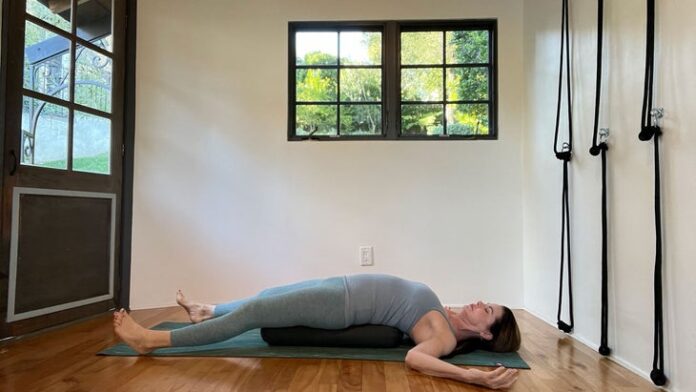“], “filter”: { “nextExceptions”: “img, blockquote, div”, “nextContainsExceptions”: “img, blockquote, a.btn, a.o-button”} }”>
Heading out the door? Read this article on the new Outside+ app available now on iOS devices for members!
>”,”name”:”in-content-cta”,”type”:”link”}}”>Download the app.
There have been several times in my life when it felt as though the Earth’s gravitational pull had doubled in my personal orbit. Times when getting out of bed was a struggle. Times when remaining upright, especially when I needed to stand in front of a room of students and teach yoga, felt like it took all of my strength.
Some of these periods of time were related to grief. Others were linked to mental health challenges. Each time I find myself emotionally burdened, I’ve found my yoga practice to be a source of tremendous lightness. Even on those days when it took everything inside of me to be vertical, I found that once I started moving my body into certain supported shapes with awareness, a little of whatever intensity I’d been carrying usually released—even when I didn’t understand exactly what had caused that heaviness.
Yoga for When You’re Emotionally Exhausted
I’ve found that when I practice yoga poses that offer an underlying energy of support and also an element of opening, I can usually find some relief and start to come back to myself. The following poses are the ones that tend to help me the most.
Setu Bandha Sarvangasana (Bridge Pose), Variation
How the pose helps: Poses that allow us to be fully supported by props incorporate gravity in order to let the body and nervous system fully settle. When we’re feeling emotionally distraught, any surface that we can collapse on—whether the floor, bed, or couch—can feel almost magnetized. It’s as though the body intuitively knows that we need to lie down and get grounded—even when we’re also in a slight backbend, which can open our body and our mind to more energy and new potential.
This variation on Bridge Pose releases the trapezius muscles, which are the diamond-shaped muscles of the upper back and shoulders. When we’re under pressure or overwhelmed, our traps tend to tighten like a turtle shell of responsibility and stress, which makes things feel even weightier.
How to: Place a bolster, a rolled-up yoga mat, stacked bed pillows, or a couple of yoga blankets folded into narrow rectangles lengthwise down the center of your mat. Sit at the edge of the bolster, mat, or blankets, facing the opposite direction, and slowly lower yourself onto the support. Adjust your body so that your lower and middle back are draped on the support and your shoulder blades and upper back are entirely on the floor.
The key to this pose is sliding your upper back away from the support as needed. You might be tempted to shimmy, but sliding will allow whatever you’re lying on to pull your trapezius muscles away from your ears, which allows your neck to be light and long. If it’s comfortable on your lower back, straighten your legs. Otherwise, keep your knees bent and your feet flat on the mat approximately hip-distance apart. Release your arms by your sides, palms facing the ceiling. Stay here for at least 20 breaths.
To come out, bend your knees and roll to one side. Take your time coming back to sitting and slowly lift your head last.
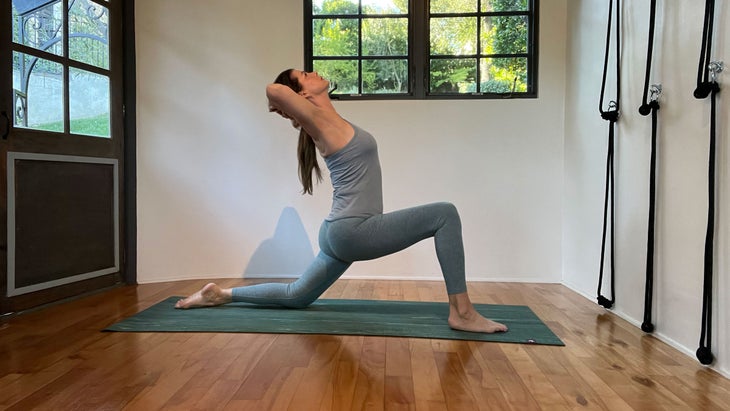
Anjaneyasana (Low Lunge), Variation
How the pose helps: During challenging periods, our bodies can seem to fold in upon themselves—our shoulders get hunched, our chests cave in, and our heads hang low. Curling inward is an adaptive response to protect our vital organs. While this is the shape we would want to make if we were about to be attacked in the wild, many of us tend to respond this way to everyday stressors, whether we cringe in response to an unpleasant email or startle at the honk of a horn. This version of Low Lunge encourages you to open your front body with a little extra support from your hands behind your head, which forms a hammock and allows you to rest your head as you open your entire front body.
How to: From sitting, come to Adho Mukha Svanasana (Downward-Facing Dog Pose), inhale and lift your right leg. As you exhale, step your right foot toward the front of the mat. Lower your back knee to the floor and, on an inhalation, lift your torso upright and reach your arms in line with your ears. Bring your palms together to touch and bend your elbows. Point your fingers down, and hook your thumbs right behind the base of your skull, with your elbows pointing upward. Inhale and lift your chest, then on an exhale, begin to lean your head back into your hands. Gently draw your hands away from you to lengthen the back of your skull as you arch your back. Look up if your neck allows or turn your gaze down toward your cheeks. Hold for 5 breaths.
To come out, on an inhalation, slowly lift yourself upright, using your hands to continue to support and lift your head. Reach your arms in line with your ears for one breath before lowering them to the floor. Return to Down Dog and switch sides.
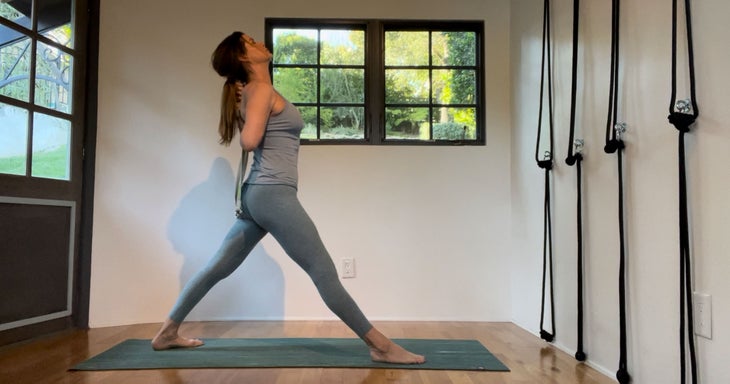
Parsvottanasana (Pyramid | Intense Side Stretch Pose), Variation
How the pose helps: Gravity is not the enemy. In fact, we can learn to use it to feel freedom and release just as much as we can use it as a form of resistance. Traditionally, Parsvottanasana is practiced as a forward bend at the hips combined with a slight backbend. The classical shape can be powerful for teaching us how to lift against pressure, but when we’re already under an enormous amount of pressure, this effort can be exhausting. Instead, adding Gomukhasana (Cow Face) arms provides support for us to lean forward, to go with gravity, if you will. In this way, using gravity doesn’t just collapse us forward, but helps us unfurl open thanks to a slight backbend.
How to: From Down Dog, come to stand at the top of your mat, with a strap, a towel, or a long-sleeve shirt draped over your right shoulder. Step your left foot back about 3 feet. Keep your feet hip-width apart. Angle your left foot forward enough that you feel stable. To take Gomukhasana (Cow Face) arms, inhale your right arm up to the sky and turn your palm to face away from you, bend your right elbow, and hold the strap, towel, or shirt in that hand. Reach your left arm out to the side and turn your palm away from you toward the wall behind you, thumb down. Bend your left elbow, and either clasp fingers or grip your strap. Inhale to bring a slight arch to your upper back, lifting your chest upward. On an exhale, start to lean back. Let the strap or your hands act as a support for your back. Stay for 8 breaths.
To come out, on an inhalation, lift yourself upright. Release your strap and step your left foot up to meet your right. Repeat on the other side.

Laghu Vajrasana (Little Thunderbolt Pose), Variation
How the pose helps: Now that we’re starting to open, let’s take on this cousin of Camel Pose that’s designed to lengthen our front body, from thighs to throat, as well as inspire elements of trust and surrender—two qualities that can be hard to access when we’re gripping tightly for any reason. Annie Carpenter, creator of SmartFLOW yoga, calls this dynamic variation “Pigeon Drops.”
How to: Come to sit on your knees and stack 2 blocks a few inches behind your bum. (If you don’t have blocks, you can situate a couch or chair there, too.) Stand up on your knees and lightly place your hands on your sacrum, fingers pointing down. On an inhalation, lift through your spine. As you exhale, move your hands to the backs of your thighs and lean back at your knees. Curl your spine so the crown of your head aims toward the blocks. Start to lean back at your knees (hello, quadriceps!) and try to touch your crown to the blocks. (You may not make it all the way, and that’s perfectly fine. The blocks are simply there to encourage a deeper arch in your spine. If your upper back still feels restricted, pile your blocks even higher so your head has support. If you are fairly mobile in this direction, you may only need one block on high.)
Once you touch your head to the block, inhale yourself upright and sit on your knees to pause. Repeat at least once more. On your third round, you may want to play with holding the shape, sliding your hands further down the backs of your legs or knees if needed. Stay for 5 breaths. Use your inhalation to come upright and sit on your heels for a few moments to pause.

Supine Vrksasana (Reclining Tree Pose)
How the pose helps: OK, now we come to the floor for a less-challenging variation of Tree Pose that is a mild hip opener as well as a release for the lower back. After the emphasis on backbending and front body opening in the previous poses, you may feel quite different than you did coming to the floor at the beginning of the sequence. It’s possible that gravity and the support of the floor will allow your chest to open even further, whereas earlier lying on the floor may have made you want to curl inward instead.
How to: Lie on your back. If you’re pregnant, have low back pain, or are otherwise unable to lie completely flat comfortably, you can prop your spine at a slight incline using two blocks (one under your shoulder blades and another under your head) or you can place a bolster atop the blocks. Pull your right heel toward your left inner thigh and allow your right knee flop open. You may observe your pelvis falling toward your bent knee leg, just allow it. Don’t worry about alignment right now. Let your body, the floor, and gravity determine the shape of your body. Take your arms wide into a cactus shape. Close your eyes or soften your gaze. Remain here for 10 breaths.
Straighten your leg and stretch before setting up on your other side.

Supta Matsyendrasana (Supine Spinal Twist), Variation
How the pose helps: The beauty of this twist lies in its openness. A number of twists rely on our body parts crossing over each other to deepen the rotation. For example, Parivrtta Utkatasana (Revolved Chair) or Parivrtta Trikonasana (Revolved Triangle) in which the bottom hand comes to the mat outside the front foot. Those twists are called closed twists. There is also a subset of twists in which the belly and chest remain unobstructed that are known as open twists. This reclining pose is the latter kind of twist.
Also, there is something psychologically neutralizing about twisting at the end of practice. It’s a metaphoric wringing out of any lingering heaviness still within you.
How to: Remain on your back, pull both knees into your chest, and pause here. Place your feet on the floor and take them a few inches wider than your hips. Keep your knees pointing upright. Stretch your arms out to your sides in a “T.” Drop your knees to the right, like windshield wipers, and turn your head toward the left. Breathe here for as long as it feels good. Inhale your knees back through center and then lower them to the other side, turning your head opposite your knees.
When you feel the stretch is complete, bring both knees back up to your chest and squeeze them in for a moment.
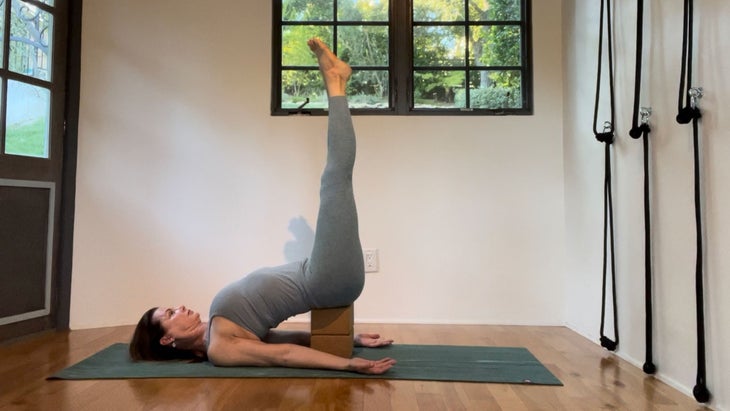
Supported Viparita Karani (Legs Up the Wall Pose)
How the pose helps: This version of Viparita Karani is sometimes called “Waterfall.” A waterfall is an incredibly powerful image of pressure eventually forming something calming and cool. Think of a strong stream pounding over the edge a cliff. If you were directly underneath it, you would likely be pushed under. But just beyond the entry point, the waterfall creates a lovely pool. It’s as though the pressure was necessary to create the calm on the other side. Supported Legs Up the Wall Pose, with our hips on a block or bolster, is a physical expression of our ability to transform pressure into softness.
How to: Remain on your back and place your feet on the floor with your knees bent. Grab your block (or bolster) and slide it underneath your sacrum. The height of the block is up to you. Some people like two blocks for more of a backbend, some prefer one block on the lowest setting. When you situate the block so you feel comfortable, release your arms down by your sides and grab the outer edges of your mat. Use your grip to exaggerate turning your upper arms externally (away from your midline) open and tucking your shoulders underneath you. Next, bring your legs up to the sky. You may start with your knees bent and even stay like that or you can choose to straighten your legs completely. Remain here for 3–5 minutes.
To come out, bend your knees and place your feet on the floor. Pause here in Supported Bridge Pose for a few moments before lifting your hips up and removing the block. Lower your back to the floor and slowly draw your knees into your chest. It may feel nice to rock right and left for a moment. Eventually roll over to one side and take your time as you use the strength of your arms to come up to sitting.
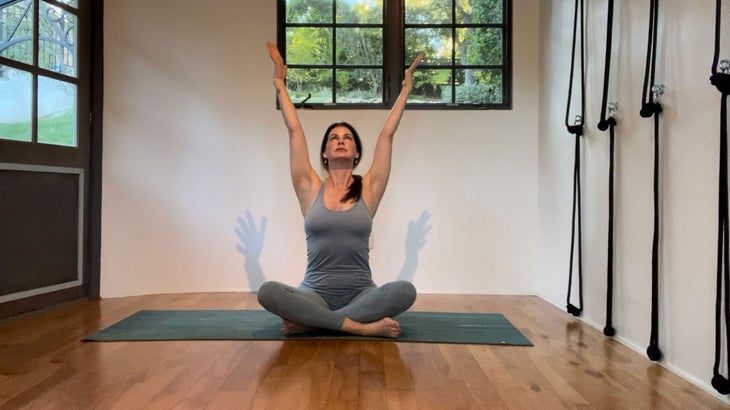
Close your practice
Choose whatever seated position is most comfortable for you and either close your eyes or soften your gaze toward the floor. Rub your palms together and, on an inhalation, reach your arms toward the sky in a “V” shape, spreading your fingers wide. Observe the effects of your practice. Know that lightness and release are your baseline, your true state, and that you can always find your way back to this.
This article has been updated. Originally published March 14, 2022.


